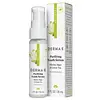What's inside
What's inside
 Key Ingredients
Key Ingredients

 Benefits
Benefits

 Ingredients Side-by-side
Ingredients Side-by-side

Aloe Barbadensis Extract
Skin ConditioningGlycerin
HumectantCoco-Caprylate
EmollientCaprylic/Capric Triglyceride
MaskingUndaria Pinnatifida Extract
Skin ConditioningGlyceryl Stearate
EmollientDiheptyl Succinate
EmollientCapryloyl Glycerin/Sebacic Acid Copolymer
Skin ConditioningGlyceryl Stearate Citrate
EmollientFucus Vesiculosus Extract
EmollientEpilobium Angustifolium Extract
Skin ConditioningPanthenol
Skin ConditioningCamellia Sinensis Leaf Extract
AntimicrobialXanthan Gum
EmulsifyingCetearyl Glucoside
EmulsifyingPotassium Cetyl Phosphate
EmulsifyingPhenoxyethanol
PreservativeEthylhexylglycerin
Skin ConditioningAloe Barbadensis Extract, Glycerin, Coco-Caprylate, Caprylic/Capric Triglyceride, Undaria Pinnatifida Extract, Glyceryl Stearate, Diheptyl Succinate, Capryloyl Glycerin/Sebacic Acid Copolymer, Glyceryl Stearate Citrate, Fucus Vesiculosus Extract, Epilobium Angustifolium Extract, Panthenol, Camellia Sinensis Leaf Extract, Xanthan Gum, Cetearyl Glucoside, Potassium Cetyl Phosphate, Phenoxyethanol, Ethylhexylglycerin
Water
Skin ConditioningMethyl Gluceth-20
HumectantPolyglyceryl-3 Laurate
EmulsifyingGlycerin
HumectantCentella Asiatica Extract
CleansingInulin
Skin ConditioningGanoderma Lucidum Extract
Skin ProtectingLactobacillus/Panax Ginseng Root Extract Ferment Filtrate
Skin ConditioningXanthophylls
Skin ConditioningCucumis Sativus Fruit Extract
EmollientPanax Quinquefolius Root Extract
AstringentPanthenol
Skin ConditioningNiacinamide
SmoothingSqualane
EmollientSodium Hyaluronate
HumectantHelianthus Annuus Seed Oil
EmollientAloe Barbadensis Flower Extract
EmollientMelia Azadirachta Leaf Extract
Skin ConditioningCoccinia Indica Fruit Extract
Skin ConditioningOcimum Basilicum Flower/Leaf Extract
TonicOcimum Sanctum Leaf Extract
Skin ConditioningCurcuma Longa Root Extract
MaskingSolanum Melongena Fruit Extract
Skin ConditioningMelia Azadirachta Flower Extract
Skin ConditioningCorallina Officinalis Extract
Skin ConditioningTapioca Starch
Xanthan Gum
EmulsifyingSucrose
HumectantDimethicone
EmollientSodium Polyacrylate
AbsorbentDisodium EDTA
Phenoxyethanol
PreservativeWater, Methyl Gluceth-20, Polyglyceryl-3 Laurate, Glycerin, Centella Asiatica Extract, Inulin, Ganoderma Lucidum Extract, Lactobacillus/Panax Ginseng Root Extract Ferment Filtrate, Xanthophylls, Cucumis Sativus Fruit Extract, Panax Quinquefolius Root Extract, Panthenol, Niacinamide, Squalane, Sodium Hyaluronate, Helianthus Annuus Seed Oil, Aloe Barbadensis Flower Extract, Melia Azadirachta Leaf Extract, Coccinia Indica Fruit Extract, Ocimum Basilicum Flower/Leaf Extract, Ocimum Sanctum Leaf Extract, Curcuma Longa Root Extract, Solanum Melongena Fruit Extract, Melia Azadirachta Flower Extract, Corallina Officinalis Extract, Tapioca Starch, Xanthan Gum, Sucrose, Dimethicone, Sodium Polyacrylate, Disodium EDTA, Phenoxyethanol
 Reviews
Reviews

Ingredients Explained
These ingredients are found in both products.
Ingredients higher up in an ingredient list are typically present in a larger amount.
Glycerin is already naturally found in your skin. It helps moisturize and protect your skin.
A study from 2016 found glycerin to be more effective as a humectant than AHAs and hyaluronic acid.
As a humectant, it helps the skin stay hydrated by pulling moisture to your skin. The low molecular weight of glycerin allows it to pull moisture into the deeper layers of your skin.
Hydrated skin improves your skin barrier; Your skin barrier helps protect against irritants and bacteria.
Glycerin has also been found to have antimicrobial and antiviral properties. Due to these properties, glycerin is often used in wound and burn treatments.
In cosmetics, glycerin is usually derived from plants such as soybean or palm. However, it can also be sourced from animals, such as tallow or animal fat.
This ingredient is organic, colorless, odorless, and non-toxic.
Glycerin is the name for this ingredient in American English. British English uses Glycerol/Glycerine.
Learn more about GlycerinPanthenol is a common ingredient that helps hydrate and soothe the skin. It is found naturally in our skin and hair.
There are two forms of panthenol: D and L.
D-panthenol is also known as dexpanthenol. Most cosmetics use dexpanthenol or a mixture of D and L-panthenol.
Panthenol is famous due to its ability to go deeper into the skin's layers. Using this ingredient has numerous pros (and no cons):
Like hyaluronic acid, panthenol is a humectant. Humectants are able to bind and hold large amounts of water to keep skin hydrated.
This ingredient works well for wound healing. It works by increasing tissue in the wound and helps close open wounds.
Once oxidized, panthenol converts to pantothenic acid. Panthothenic acid is found in all living cells.
This ingredient is also referred to as pro-vitamin B5.
Learn more about PanthenolPhenoxyethanol is a preservative that has germicide, antimicrobial, and aromatic properties. Studies show that phenoxyethanol can prevent microbial growth. By itself, it has a scent that is similar to that of a rose.
It's often used in formulations along with Caprylyl Glycol to preserve the shelf life of products.
Xanthan gum is used as a stabilizer and thickener within cosmetic products. It helps give products a sticky, thick feeling - preventing them from being too runny.
On the technical side of things, xanthan gum is a polysaccharide - a combination consisting of multiple sugar molecules bonded together.
Xanthan gum is a pretty common and great ingredient. It is a natural, non-toxic, non-irritating ingredient that is also commonly used in food products.
Learn more about Xanthan Gum